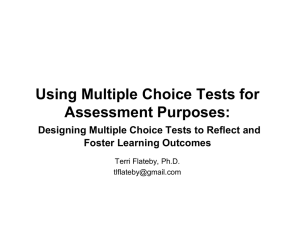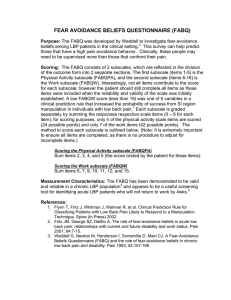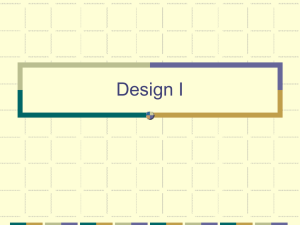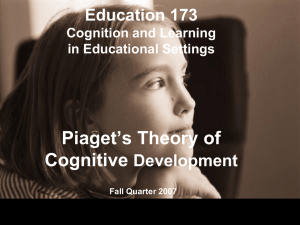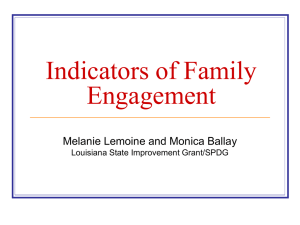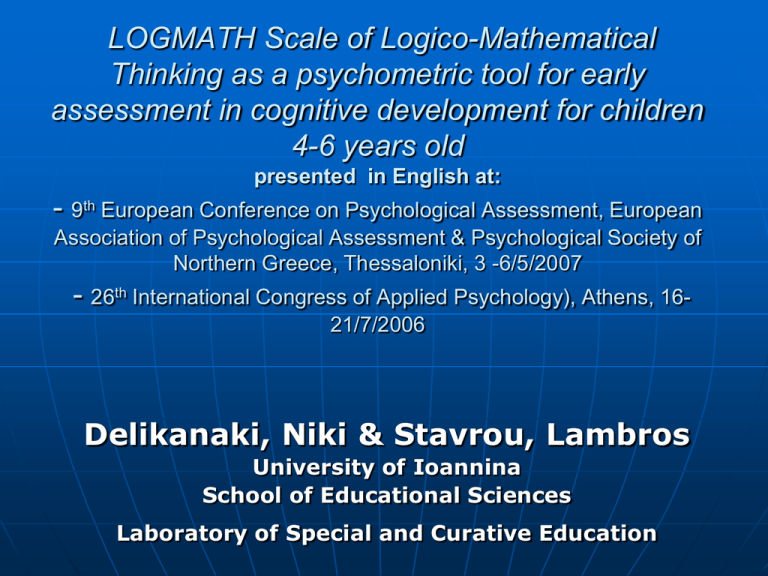
LOGMATH Scale of Logico-Mathematical
Thinking as a psychometric tool for early
assessment in cognitive development for children
4-6 years old
presented in English at:
- 9th European Conference on Psychological Assessment, European
Association of Psychological Assessment & Psychological Society of
Northern Greece, Thessaloniki, 3 -6/5/2007
- 26th International Congress of Applied Psychology), Athens, 1621/7/2006
Delikanaki, Niki & Stavrou, Lambros
University of Ioannina
School of Educational Sciences
Laboratory of Special and Curative Education
Departing point:
Early screening of difficulties are of
great importance for children’s life.
1. Aims to:
1. Early screening of dysfunctions in cognitive
development, through evaluation of logicomathematical thinking, and identification of
children at risk of possible relevant L.D.
2. Evaluation of the level of school readiness,
ending kindergarten.
3. Enrichment of our knowledge & understanding
about logico -mathematical thinking in preschool
children.
2. 1. Researching for content: a. Survey of tests
A: Mathematical ability
Scale for the evaluation of mathematical
ability, Prof. Georgas D. & Mihou-Karidi
M., «Mathematics-Diagnostic, PreschoolGrade 3», coll. of 50 math tests,
Education Testing Service, USA.
B: Neyropsychological tests and of cognitive
ability
Athena-Test of L. D., Paraskevopoulos,
Kalatzi-Azizi & Giannitsas, Zazzo-GillyVerba Nouveau Echelle Metrique de l’
Intelligence, WPPSI, Raven Progressive
Matrices, Bender test, Wisconsin Card
Sorting Test, ACFS etc.
b. Theoretical approach
Contemporary models of cognitive
development
Information processing approach to
cognitive development
Domain specificity cognitive theories
Neyropsychological data
2.2 Test plan and item construction
Main aims of the concepts (vertical)
expressed as cognitive domains
(subscales)
Aims of relevant behaviors (horizontally)
Proportion representative in each domain,
large rank of possible items of graduating
difficulty (120)
2.3. Two pre-researching periods
1st period: reforming, rejecting and
checking psychometric properties for
a large rank of items
2nd period: distribution of the test to
36 children (18boys and 18girls) of 3
groups of age (4, 5, 6 years)
3. The standardization
(3d period)
3.1.The Sample: 410 Kindergarten children, 205 boys and
205 girls, 4-6 y, from the 4 departments of Crete
LASSITHI
4,00
1,00
12,4%
24,4%
2,00
IRAKLION
50%
CHANIA
RETHYMNO
3,00
13,2%
Researching periods
1st period
2nd period
3rd period
(Standardization)
4th period
5th period
(assessment (intervention)
1st grade)
(Pre-researching)
(Pre-researching)
Period
Oct. 2000Oct. 2001
Dec. 2001
1/2/2002 –
15/4/2002
May 2003
N
N=93
Ν=36
Ν=410
Ν=83
Method
Item
Assessment by
LOGMATH
Assessment
by
reformed
LOGMATH
Math test
distribution
LOGMATH
distribution
May 2004
N=20
3. 2. Method of research
Individual interview
Questionnaires to teachers and
parents.
One year later a test of mathematical
ability was administered to a part of
the sample ending the grade 1 of the
Elementary school (N=83)
4. Description
LOGMATH is consisted of 5 subscales:
(56 items)
1) spatial ability
2) time
3) sequencing and repetitive
patterns
4) classification
5) number
Subscale: Spatial Ability
X1.shape perception by subtraction
X2. mental rotation
X3. spatial orientation model a
X4. spatial orientation model b
X5. spatial orientation model c
X6. copy of shapes
Subscale: Time
(sequences)
An example story is integrated at the
beginning from the examiner
Δ7. sequential story integration a
Δ8. sequential story integration b
Δ9. sequential story integration c
Subscale: Sequencing and
Repetitive Patterns
A. Sequencing
Σ10.seriation of pictures by height
and age
Σ11.seriation of cubes by size
Σ12.seriation by height and
insertion
B. Repetitive patterns
Α13.pattern of colors a
Α14.pattern of colors b
Α15.pattern of images
Subscale: Classification
Τ16. class of similar (one shape differs)
Τ17. class of similar ( color differs)
Τ18. classification
Τ19. grouping pictures
Τ20.matrix of classification
Τ21.class of fruits
Τ22.class of clothes
Τ23.class of tools
Τ24.class of birds
Τ25.class of furniture
Subscale: Number
Ν26. cardinality from 3 to 6
Ν27. number conservation
Ν28. cardinality from 7 to 10 and 13
Ν29. digital numbers from 1 to 10
Ν30. visual memory calculation
problem a
Ν31. visual memory calculation
problem b
Ν32. visual memory calculation
problem c
Characteristics
Administration: individual
Mean time of testing: 23 minutes
General performance
Performances for each subscale
Norms in quartiles and z values
5. ITEM ANALYSIS
5.1. Item difficulty
according to the purpose of the Scale more items
with low/middle difficulty, fewer with higher one.
Items inside each subscale respect graduating
degree of difficulty.
1,2
1,0
,8
Value DIFFIC1
,6
,4
,2
1
3
5
Case Number
7
9
11
13
15
17
19
21
23
25
27
29
5.2.Item discrimination analysis
A: method of item correlation to total
score, by Pearson r.
Category A >0,40
: 41 items
Category B 0,25-0,39 : 9 items
Category C <0,25
: 0 items
B. method item total correlation by
Cronbach’s alpha if item deleted
,932
Correlations between subscales
Spatial
Time
Seq/Pat
Classif.
Number
T. score
**p<,01
Spatial
1
,60**
,65**
,50**
,70**
,84**
Time
1
,63**
,52**
,61**
,78**
Seq/Pat Classif. Numb Tot score
1
,54**
,70**
,87**
1
,53**
,70**
1
,90**
1
6. Reliability analysis
A. Cronbach-alpha a =,93
Ν=410 and N of items =56
B. Guttman Split-half = ,85
Alpha: part 1=,87
part 2=,91
C. Reliability between parts for
odd and even numbers of items
r= ,92
7. Validity
7.1. Criterion related validity
A. Concurrent validity
Criterion to total Score correl.: r= ,69**
(p<,01)
B. Predictive validity
Criterion a (evaluation) to Total Score,
correl.: r = ,55** (p<,01
N=83)
b. Criterion b (Math Test grade 1st) to total
Score correlation:
r=,51** (p<,01 N=83)
7.3. Construct
7.2. Content
validity
This examination is
considered:
a) if the items are
relevant to the
domain of the
examined ability
b) if they are
representative of
the domain
validity
Factor Analysis
1 Component with
eigenvalue>1.00
Explains 68% of
the variance
Factor analysis for
each subscale too,
displayed construct
validity
Other results
No Sex differences
except in X6 item
(shape copying in spatial ability subscale,
boy (red): Μ=2,9
Range: 1-5)
SD=1,40
girl (green):Μ=3,3 SD=1,36
40
30
20
Percent
10
gender
boy
0
girl
,00
,50
ecopy
1,00
1,50
2,00
2,50
3,00
3,50
4,00
4,50
5,00
Linear regression explains 50,5% of
the total variation and showed the
predictive variables:
Age: 32.3%
Proccessing speed: 9.3%
Status of parents: 7.7%
Age of starting walking: 1.2%
Developmental differences
between every semester of age
80
60
40
GSKORCAT
Count
20
1,00
2,00
0
3,00
4.0-4.6y
age
4.6-5.0y
5.0-5.6y
5.6-6.0y
Correlation between achievement time and total scoring:
-,45**(p<,01), the “faster” ones get higher total scoring
The faster
The slowest
10,3%
10,9%
14-19
in 14-19΄
The medium
78,8%
in 20-27΄
20-27
28-39
in 28-39΄
Development in each domain does not follow the same
process
100
200
80
60
100
40
20
Std. Dev = 2,87
Mean = 9,3
Std. Dev = 1,94
Mean = 4,1
N = 410,00
0
1,0
3,0
2,0
5,0
4,0
7,0
6,0
9,0
8,0
11,0
10,0
13,0
12,0
N = 410,00
0
0,0
SKSPACE
1,0
2,0
3,0
4,0
5,0
6,0
SKORTIME
Total score: Spatial ability
Total score: time sequence
100
120
80
100
80
60
60
40
40
20
Std. Dev = 2,01
20
Std. Dev = 3,44
Mean = 7,7
Mean = 6,0
N = 410,00
0
0,0
2,0
4,0
6,0
8,0
10,0
12,0
SER.SEQ
Tot score:Sequencing/patterns
N = 410,00
0
0,0
2,0
1,0
4,0
3,0
6,0
5,0
8,0
7,0
10,0
9,0
11,0
SKORCLAS
Total score: classification
,5
,5
,4
,4
,3
,3
Mean
Mean
,2
,2
e51(3)
e53(5)
e52(4)
e56(7)
e54(6)
e58(9)
e57(8)
E60NOMIN
e59(10)
Numbers cardinality 3-10, 13
60
50
40
30
20
10
Std. Dev = 4,41
Mean = 8,4
N = 410,00
0
0,0
2,0
1,0
4,0
3,0
6,0
5,0
8,0
7,0
10,0
9,0
11,0
12,0
14,0
13,0
skornumber
Total score: number
,1
e62.1
e64.3
e63.2
e66.5
e65.4
e68.7
e67.6
e70.9
e69.8
Digital numbers 1-10
e71.10
5% (in total score) are appeared in
severe cognitive dysfunction
50
40
30
20
10
Std. Dev = 12,31
Mean = 35,4
N = 410,00
0
2,5
12,5
7,5
22,5
17,5
32,5
27,5
42,5
37,5
52,5
47,5
GSKOR
Total score of the Scale
Our belief
the research must be promoted
get to the Knowledge
support the institutional services
help the children in impairment
THANK YOU
E-mail: n_delikanaki@yahoo.gr


